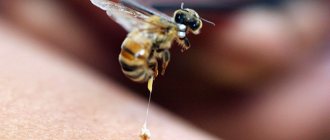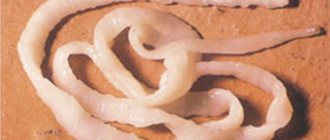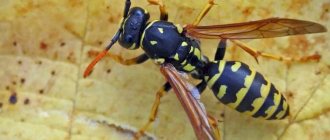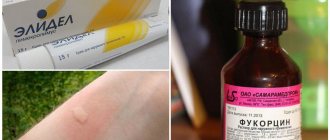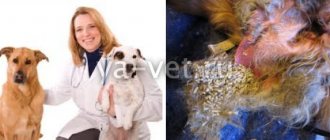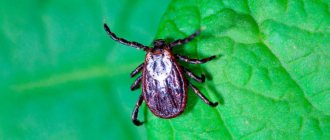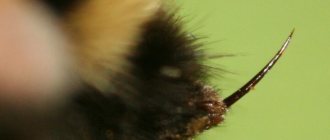Bee sting: is it dangerous?
When bees bite, they dig into the skin of a domestic animal and leave a sting in it, which contains barbs and a poisonous sac.
If the dog encounters not a bee, but a hornet, bumblebee or wasp, they may also bite. Dog and bee
Note! Bees don't bite, they sting. They can do this only once, after which they die, leaving a sting in the enemy’s body with part of their intestines.
After a bee sting, the animal's paws and nose usually swell. But in addition, other troubles may develop:
- Anaphylactic shock is a consequence of an allergic reaction to an insect bite. Main symptoms: blisters form on the skin, severe swelling of the tissues and skin, wheezing is heard during breathing, possible vomiting, convulsions, involuntary bowel movements and gall bladder, and a plaintive whining.
- Suffocation. It’s not so scary if the dog is stung by an insect, for example, on the paw. It is much worse if a honey insect flew into the mouth of a curious pet. In most cases, the dog's oxygen supply is blocked, so assistance must be provided immediately.
- An allergic reaction develops mainly only if the dog is bitten by several bees at the same time or with a slight difference in time. Against this background, the following symptoms may develop: severe itching and swelling at the site of the bite, upset of the digestive tract, and fever.
Slight swelling and a single squeal are a normal reaction and there is no cause for concern. If more severe symptoms develop, you must take your dog to the hospital immediately, otherwise it can lead to death.
Symptoms of a Dog Insect Bite
A cat was bitten by a wasp or a bee: what to do at home
If your dog is bitten by a bee, you need to carefully monitor your pet's condition for a while. If alarming symptoms appear, your pet should be taken to a veterinarian as soon as possible.
Dachshund bitten by bees
A dog bee sting may be accompanied by the development of the following clinical picture:
- the dog whines and jumps away from the bite site or, on the contrary, tries to attack;
- after a short period of time, pain and swelling develop at the site of the bite, the muzzle becomes swollen;
- if the bite site is in the mouth, then the palate and mouth swell primarily, the dog cannot close it, and there is abundant salivation.
Subsequently, symptoms develop individually. A puppy and an adult dog may experience rapid heartbeat and fever, feverish trembling, vomiting and diarrhea, unsteadiness of gait, disorientation in space.
Bite signs and symptoms
There are situations in which the dog owner misses the moment of the bite, in which case it is necessary to determine whether the attack was caused by a bee or a wasp. If a bee suddenly bites a dog for unknown reasons, a sting remains at the site of the wound, periodically pulsating and releasing more and more poison into the blood. During a wasp attack, the bite can be applied several times, but this insect does not leave a sting.
In addition to physical symptoms, the dog’s mood will most likely begin to change - his health will worsen, and his temperature may rise. If a puppy is attacked, it will be easier to identify the bite, since the small pet will whine loudly and ask for help from the owner.
There is a short list of symptoms that will help determine whether a bite has been inflicted:
- the appearance of edema;
- formation of dried blood in the bite area;
- strong temperature fluctuations;
- increased salivation;
- sudden loss of appetite;
- severe fatigue;
- vomiting reflex;
- difficulty breathing;
- the formation of urticaria on the body;
- the appearance of a purple tint on the tongue;
- foaming at the mouth;
- sudden convulsions;
- fainting.
Bite in the face
If a wasp bites a dog in the face as a result of an animal’s aggression, you should urgently contact a veterinarian. It's all about the location of a large amount of soft tissue on the dog's face, as well as the presence of mucous membrane in the mouth area. Often the dog tries to catch an insect with its mouth, not suspecting that it will receive serious injury from a small enemy.
Dogs of small breeds, such as pugs, dachshunds, Pekingese, quinines, etc., suffer most from bites in the face. This problem lies in the manifestation of a high heart rate in small dogs. Accordingly, the poison spreads throughout the body much faster and causes an increase in temperature that accompanies intoxication.
When an animal's muzzle suffers, it is very easy to determine - the dog barks loudly and tries to smooth out the bite site with its paw. In frequent cases, loss of appetite occurs, swelling occurs, and the airways become inflamed.
Bite on the paw
An attack of this kind causes the least harm, however, the animal cannot avoid physical pain. If a dog is bitten on the paw by a wasp, it immediately begins to lick the damaged area, tries not to step on the affected limb, and howls while walking.
Basically, with such a bite, animals get off with mild fear and stress, resulting in general weakness. When a paw is damaged, inflammatory processes occur on it, as a result of which the dog cannot fully stand on the limb.
Bite to the body
If bitten in any area of the body, a wide variety of consequences can occur. Basically, such an attack is accompanied by swelling, hives and general weakness, however, there are situations when the animal loses consciousness or suffers anaphylactic shock. It all depends on the bite area, since the dog’s body has soft tissues that quickly absorb the poison and distribute it throughout the body.
Bite on the tongue area
The most dangerous place for a bite is the tongue area. The fact is that in the sublingual area there is a large number of nerve endings and blood vessels. After being bitten on the tongue, the pet experiences a convulsive reaction and the front muscles begin to contract involuntarily.
In this case, the animal must be placed on its right side and try to calm it down. If the condition does not return to normal within 5 minutes, you should immediately call a veterinarian.
Signs of a bee sting in dogs
- swelling at the bite site
- facial swelling
- redness
- pain at the bite site
- itching at the bite site
- difficulty breathing
- weakness
- vomit
- diarrhea
- convulsions
- nervousness
- dizziness
- salivation
While some bee stings are minor, others can cause life-threatening symptoms in your dog. Symptoms of a bee sting are similar to those in humans and usually include only swelling, redness, pain and mild itching around the sting site . Sometimes there may be hives on the body. These symptoms are usually not very severe and are of short duration. However, other symptoms can be very worrying. Some dogs may experience difficulty breathing, vomiting and diarrhea, nervousness, watery eyes, weakness, dizziness and even seizures. These symptoms usually appear within about 20 minutes, but may not appear for several hours after a bee sting.
The first symptom of a bee sting is usually barking or howling from the dog after the sting. If a bee stings your dog on the leg, he may limp, hold his paw, or lick it. If the sting is on your dog's face or mouth, he may lick his lips and rub his face on the ground. Redness and swelling at the site of the bite occurs quite quickly before other symptoms.
Treatment for bee stings in dogs
If your dog is stung by a bee, you don’t need to panic right away, you should first monitor the dog’s breathing. If your dog has trouble breathing at any time or shows signs other than minor redness, itching, pain and swelling at the bite site, your veterinarian should see it as soon as possible. Sometimes home care is not enough and quick-acting injections of steroids and antihistamines along with oxygen therapy are required.
Here is a list of things you should do if your dog is stung by a bee.:
- Remove the stinger - First remove the dog's stinger, if you can find it. Do not use tweezers to remove the sting as this may force out more venom.
- Disinfect the bite site - After removing the sting, you can apply a mixture of baking soda and water to create a soothing paste on the bite site.
- Reduce Swelling – To reduce swelling, you can hold an ice pack on the bite site for 10 minutes.
- Protect the bite site from your dog's influence - If your dog is scratching the bite site and injuring himself, it may be worth trying to put a sock on your dog's foot to reduce the risk of further injury.
- Call your veterinarian – Finally, call your veterinarian to make sure it is safe to give your dog an antihistamine, such as diphenhydramine . This medication will reduce bee sting symptoms and help your dog feel more comfortable.
Remember to use common sense and remain calm, as nerves will only hurt you. Dogs take on our emotions.
What to do if your dog is bitten by a bee
Just like people, pets can experience allergic or inflammatory reactions due to stings from a variety of insects, including hornets, bees and wasps, etc. The safest strategy is to avoid collisions with them. But if this happens, you need to take steps to protect your pet's health. In our article we will tell you what to do if your dog is bitten by a bee, hornet or bumblebee.
Avoid contact with insects
This advice is especially important if your pet has had a history of allergies to bee stings. While walking your dog, try to avoid places that could be a potential source of bees: open fields, flower beds, forest, park, etc.
If your dog spends most of his time in the country, grow chrysanthemums, lemongrass and primroses in the yard. These flowers look beautiful, but at the same time they do not attract bees. Also teach your pet not to stick his nose where it shouldn’t be - flower buds, holes in the ground, hollows in trees and, of course, beehives.
If, despite all safety measures, your pet is still bitten, be prepared to provide first aid.
Dog bitten by a bee: first aid
If you notice that your pet is actively licking the same place on a paw or other part of the body, check - this may be swelling from a bite. Some animals, like people, can experience anaphylactic shock after being bitten. This reaction can be fatal.
If you notice any of the following symptoms, which usually occur within an hour of the bite, take your pet to the vet immediately:
- Severe and profuse swelling (the entire muzzle, not just the lip or nose);
- Difficulty breathing or increased breathing effort - possibly due to swelling of the throat;
- Very pale membranes (inner lips and gums);
- Fast and/or irregular pulse;
- Increased capillary refill time. If the gums are pale or if the color returns to the gums when pressed with a finger for more than 2 seconds, your pet needs immediate medical attention.
Even if your pet doesn't have a severe reaction, the bite site may be painful or uncomfortable.
Bee sting treatment
If the insect bite is in the mouth, offer your pet an ice cube or small amount of ice water to minimize swelling. Mucous membranes absorb toxins much more quickly, so inspect your dog's lips, gums and tongue. If the tongue is swollen, take your pet to the vet immediately.
It often happens that the bite occurs in the body or limbs of the dog. In this case, the sting is hidden in the pet's fur. Carefully examine the swelling - perhaps the sting is still inside. Feverish inspection and accidental pressure can drive the sting even deeper. If you find it, do not pull the sting with your fingers or tweezers. This will only make the situation worse by damaging the poison sac, allowing more toxin to enter your pet's body.
If you have an EpiPen prescribed specifically for your pet due to previous allergic reactions, use it according to the instructions provided. Consult your veterinarian immediately as anaphylaxis may occur.
Diphenhydramine will help relieve mild allergic reactions and calm your pet, allowing him to relax and prevent him from scratching the bite site. If possible, use a liquid solution of the medicine. After piercing the capsule, drop the liquid directly under the animal’s tongue. The abundance of blood vessels in the mouth allows the medicine to be absorbed into the bloodstream more quickly. If swelling persists for more than 6-8 hours, contact your veterinarian for further treatment.
If you find a bite site, treat it with a special paste. To prepare it, take a tablespoon of baking soda and a few drops of water. Baking soda has an alkaline base and counteracts the high acidity of the toxin.
A cold compress will help reduce swelling. However, don't go overboard if you use cubed ice. Remove the compress periodically, otherwise the dog may get frostbite or develop a cold.
Conclusion
Of course, bee stings don't always happen when you're at home, so make sure your first aid kit in your car and your hiking backpack have everything you need to treat your pet in the event of a bee sting or other stinging insect. We hope our tips will help you in a situation where your dog has been bitten by a bee, bumblebee or hornet.
tell friends
Vkontakte Facebook
First aid
In the event of a bite, behave calmly, do not panic or scold the dog under any circumstances: after all, the dog is already stressed from pain and surprise. Take the following actions as soon as possible:
- Pull out the sting if there is one.
Insects sting in different ways: for example, a sting remains at the site of a bee sting; wasps, bumblebees and hornets do not leave it. Therefore, if a dog is bitten by a bee, the sting must be removed immediately. This can be done using tweezers, nails, nail scissors, or a handy tool such as a plastic card. There is a sac with poison on the bee sting, so it must be pulled out carefully, using sliding movements, so that the remaining toxic substance is not squeezed out and does not enter the animal’s blood. - Treat the stung area.
Apply a gauze or cotton swab soaked with water and ammonia to the dog's paw, nose or lip. The bite can also be washed with alcohol or even regular vodka. If you don’t have anything like this on hand, just rinse with water. - Apply a cold compress.
Cold helps reduce swelling, reduce pain and slow down the absorption of bee venom. Do not keep the ice pack on for more than 15 minutes. During all these manipulations, talk to the dog and calm it with your voice. - Use folk remedies.
the cous can be treated with grated parsley leaves, dandelion juice, plantain or honey. - In case of numerous bites, provide the dog with plenty of fluids
- this will help the toxic substances leave the dog’s body faster. - Lubricate the wound with an anti-allergic ointment that relieves itching
. This is important because, as any dog lover knows, a dog can easily scratch an itchy bee sting and cause an infection. As such a remedy, you can use fenistil, lorinden, one percent hydrocortisone ointment, etc. - Give your dog an antihistamine.
One tablet of suprastin, loratadine, diphenhydramine or tavegil will be enough.
As a rule, these measures are sufficient for a bite on the paw. During the first time after a bite, observe the dog as carefully as possible in order to promptly notice the manifestation of an acute allergy to the bite of a poisonous insect.
What to do in case of an acute allergic reaction
If the dog has been stung for the first time, the risk of allergies is less than with subsequent bites. The following symptoms indicate that the consequences for the dog were much more serious than usual:
- heavy or difficult breathing;
- severe swelling of the stung area;
- foam from the mouth;
- vomit;
- tongue color changes to purple;
- loss of consciousness.
In this situation, you need to immediately give an injection of an antihistamine and urgently take the dog to a veterinary clinic.
Allergy
While walking, your dog was stung by a bee or wasp, developed an allergic reaction, and you don’t know what to do? It is urgent to administer an antihistamine. This may be chloropyramine or tavegil. Diphenhydramine shows good results, but pharmacies sell it with a doctor's prescription. Medicines are administered by injection. The dose is selected depending on the size of the bitten dog (its weight).
- up to 10 kg - 0.1 ml/kg;
- from 10 to 20 kg - 1 ml;
- more than 20 kg - 2 ml.
What should you do if your dog is bitten by a wasp on the cheek or lip and severe swelling develops ? A glucocorticosteroid drug, dexamethasone, . It is an immunosuppressive, anti-inflammatory drug. Used for anaphylactic shock, edema, acute manifestations of allergies. The dosage of the medicine is selected taking into account the size of the dog according to the formulas specified in the instructions.
What to do if a puppy or an adult is bitten by a bee, and the sore spot is itchy and itchy? will help : fenistil, sinaflan . Or traditional hydrocortisone ointment (1%).
You should not self-medicate if the animal has developed an acute form of allergy: the tongue has turned blue, heavy breathing has appeared. You should immediately take your pet to a specialist.
The most dangerous bites
If an animal is stung on the paw, that’s not so bad. But it often happens that the insect attacked the neck, muzzle, eye or mouth cavity. A bite on the lip, tongue or palate usually occurs due to the dog accidentally swallowing an insect, and this is especially dangerous: rapidly developing swelling of the tongue or palate can block the access of air to the respiratory tract, and this, in the absence of medical assistance, can be fatal.
In the photo, a bee bit a dog in the face
Bites on the nose are the most painful for dogs, because this area is very sensitive. The consequences here can be the same as in the case when a dog is bitten by a bee (or wasp) in the cavity of the mouth or neck - swelling that blocks the ability to breathe.
In such especially dangerous cases it is necessary:
- immediately inject an antihistamine;
- remove the sting as quickly as possible;
- take the animal to the doctor as soon as possible, where it will receive qualified assistance.
If the condition is particularly rapidly deteriorating, there is no point in spending precious time treating the bite site; the veterinarian will do all this anyway. The main thing is to prevent the possibility of death through coordinated actions and quick delivery of the dog to the veterinary center.
Antiallergic drugs
In case of a bite in the face or lip, or the onset of an acute allergy, it is necessary to give injections rather than give tablets: the latter act too slowly, and the stung area swells very quickly. Therefore, dog breeders should purchase a couple of ampoules of the following drugs so that they are always on hand in their home veterinary medicine cabinet. You should also take the ampoules with you during trips to nature - to keep them safe and sound, wrap them in foil.
- You can buy suprastin or tavegil in ampoules at the pharmacy without a prescription. Diphenhydramine is also suitable - but, unlike the previous ones, it is available with a prescription.
- Dexamethasone, also in ampoules.
In case of severe swelling, some veterinarians recommend additionally injecting the dog with a diuretic (furosemide) and magnesium.
Treatment and relief of edema
Was your dog bitten by a wasp? There is a high probability of developing inflammation and swelling. Swelling may appear immediately after the poison enters the body, or over the next 2-3 hours. To eliminate the condition, medications and folk remedies are used.
Pills
Animals with edema that have been bitten by insects are prescribed the following medications:
| Name | Release form | Dosage |
| Prednisolone (steroid hormone) | 5 mg tablets | 0.5-1 mg per 1 kg of weight (every 12 hours) |
| Fenkarol | tablets 10 mg, 25 mg | 10-15mg /2 times a day |
| Clemastine | 1 mg tablets | 0.05-0.1 mg/kg (every 12 hours) |
| Medrol(methylpred) | 5 mg tablets | 0.4-0.8 mg/kg |
| Zodak (cetirizine) | 10 mg tablets | 1 mg/kg (interval – 24 hours) |
Medicines are convenient to use. Before use, they must be crushed and turned into powder . Dosage for treatment should be discussed with your veterinarian during an in-person visit or by telephone.
If a dog that has been bitten by stinging insects develops swelling, doctors recommend using diuretics. For example, Lasix, torsemide, veroshpiron, hypothiazide. In this case, it is necessary to provide the animal with plenty of fluids .
Ointments
What else needs to be done for swelling if the dog has been bitten by bees or wasps? Use anti-inflammatory, analgesic ointment Indovazin . It should be used together with the drug Famotidine , a gastrointestinal protector.
Dexamethasone ointment, which has antiallergic and decongestant properties, effectively helps against bites. It will relieve a dog that was bitten by insects while walking from pain, swelling, itching, and hives.
Glucocorticoid ointments show high effectiveness in treatment: elocom, advantate . They are also available in the form of cream and suspension. They are hormonal drugs. Relieves inflammation, swelling, reduces tissue susceptibility to allergens.
Typically, ointments are applied 2 times a day (morning and evening) until the swelling subsides. Any medications can cause allergies. If it occurs, you should stop using the drug and consult a veterinarian.
Traditional methods
What to do if an insect bites a dog, but there is no way to use pharmacological agents? Minor swelling, inflammation, and itching can be completely dealt with using traditional methods, using the healing properties of plants.
- Aloe vera . The juice of this succulent has been used for centuries to treat skin diseases. It relieves swelling and inflammation. Relieves rashes and severe itching. If a puppy or adult dog is bitten by a wasp while walking, you can apply the pulp of the plant to the sore spot.
- Echinacea . Dogs that have been bitten by bees or wasps in the summer are given a lotion with a decoction of this plant. Echinacea is a natural antiseptic and antiviral agent. Effectively helps with symptoms of snake bites.
- Pharmaceutical camomile . The plant heals wounds, reduces inflammation and swelling in pets. Medicinal decoctions are prepared from chamomile, which are used for compresses on the bite site.
- Plantain . It is a kind of ambulance. Owners remember it as soon as the question arises: what to do if a dog was bitten by a wasp or a bee while walking. A leaf of the plant can be applied to the wound, kneading it in your hands to release the juice.
- Bulb onions . You can apply half of the whole head to the affected area, cut side down. Another way is to chop the onion using a knife or blender. Apply the resulting pulp to the bite site through gauze so as not to cause a skin burn.
Herbal lotions are good for wasp bites. They may include, in addition to the above plants, calendula, comfrey leaves and roots, mint, lemon balm, parsley, dandelion. You can enhance the effect with honey. It will help draw out the poison that remains after removing the insect sting from the wound.
“Green healers” are used to prepare healing infusions for allergies. 1 tbsp. l. dry raw materials are poured with a glass of water, put on fire and boil for 3-5 minutes. The resulting product is given to the animal 30-50 ml with each meal. For these purposes, nettles, wild rosemary, yarrow, oak bark, blueberries, and cinquefoil are used.
The owner should be aware that herbal infusions and teas may taste bitter. Getting your pet to drink them for treatment is quite difficult. What to do? Sweeten the resulting infusion with dextrose or glucose to make it pleasant to drink. For internal use, you can use dry herb. It is recommended to finely chop it and mix it with meat or minced meat.
Traditional methods of treatment must be coordinated with a veterinarian. Many plants, if used incorrectly, can cause harm to animals. Only a doctor knows what to do and how to use them correctly if a four-legged friend is bitten by a bee.
How to understand that you can’t do without a veterinarian
Any allergic reaction (especially anaphylactic shock) is always a good reason to urgently take your dog to the veterinarian! In addition, it is worth going there if:
- puppy bitten
- signs of developing suffocation are noticeable,
- the dog received multiple bites,
- bites were found on the neck, on the organs of vision or directly on the mouth,
- when a little later suppuration of the bite site is noted, lethargy, high temperature, decreased or loss of appetite, and apathy appear.
What medications does the veterinarian administer?
- calcium chloride: slowly, intravenously 5-25 ml, depending on the size of the dog and the severity of the allergic condition. The course varies, usually once a day for 1-3 days.
- dexamethasone: subcutaneously or intramuscularly 1-2 ml once.
- prednisolone: 1-3 ml into the muscle once a day for 1-5 days, depending on the severity of the allergy and the condition of the dog.
- Diphenhydramine (Benadryl, diphenhydramine): up to a maximum of 2 ml intramuscularly as symptoms develop and resolve. The drugs may cause drowsiness.
- tavegil: from 0.5 to 2 ml into the muscle, depending on the severity of the allergy and the weight of the dog.
- aminophylline 2.4%: 0.05-0.1 g subcutaneously or intramuscularly symptomatically, if there is a risk of developing allergic pulmonary edema.
- cordiamine: subcutaneously from 0.3 to 2 ml, depending on the size of the animal. In special cases, the drug can be dripped under the tongue.
- adrenaline 0.1%: administered in particularly urgent cases only by a veterinarian in the dosages established by him, depending on the severity of the animal’s condition.
- diuretic to relieve edema (usually Lasix or furosemide): intramuscularly from 0.5 to 2 ml once, maximum 2 times a day and no longer than 3 days.
Most often, the dog’s body copes with stinging insect bites on its own. However, sometimes qualified help may be needed. Soreness and swelling subside after 3-10 days, depending on the body's individual reaction to insect toxins and how much poison was injected into the wound. You should always keep an “emergency” ampoule of prednisolone, diphenhydramine or dexamethasone in your home medicine cabinet in case you develop an allergic reaction to wasp and/or bee stings.
Prevention
We looked at the symptoms, treatment and prevention if your dog is stung by a wasp or bee. Is there any way to protect your pets from stinging insects? This cannot be done completely. But you can minimize the risks.
You should keep an eye on your pet while walking. Keep it away from flowering plants and berry bushes. This is especially true for active breeds. After all, you can often meet, for example, a curious dachshund that was stung by a bee while out for a walk. But a calmly walking French bulldog rarely becomes a victim of stinging insects.
The walking area should be checked for wasp nests. By following these rules, the number of bites will be kept to a minimum. The dog owner must have a first aid kit containing the medications necessary to provide medical care.
Prevention of attacks
When walking with your animal, you need to ensure its safety. To do this, do not allow your pet near dense bushes with flowering plants and berries. It is in such places that wasps are most often found. Particular attention should be paid to active breeds, as such dogs show more interest in their surroundings.
Advice! It is best to check the walking area for insects. By following these rules, the owner of the animal will be able to protect his pet from a sudden attack.
By following safety rules and having a veterinary first aid kit with you, you can protect your pet from unforeseen situations. You should be vigilant and closely monitor the animal that is in the territory of flowering plants.


